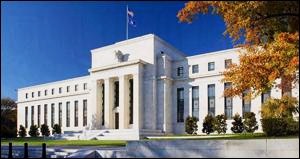By Pam Martens and Russ Martens: June 22, 2016
Talk about bad timing. Tomorrow, while the Brexit vote takes place in the U.K. and is guaranteed to whipsaw markets through the Friday morning open when the results of the vote are expected, the Federal Reserve plans to add to market jitters on Thursday by announcing the results of its stress tests on the biggest banks — while withholding the final leg of the results until the following Wednesday.
The stress tests are an annual Fed exercise which are meant to reassure the public and Congress that the mega banks are holding adequate capital for even an extreme economic downturn; in other words, that another epic taxpayer bailout of insolvent banks won’t sneak up on the Fed like it did in 2008.
Unfortunately, according to the Federal agency established under the Dodd-Frank financial reform legislation to provide ongoing research on potential systemic risks within the U.S. financial system, the Office of Financial Research (OFR), the Fed’s annual stress tests fail to measure the biggest problem in the current U.S. financial structure – the unprecedented concentration of counterparty risk.
The OFR researchers, Jill Cetina, Mark Paddrik, and Sriram Rajan, say the problem is not what would happen if the largest derivatives counterparty to a specific bank failed, as the stress tests currently measure, but what would happen if that counterparty happened to be the counterparty to other systemically important Wall Street banks.
By focusing on “bank-level solvency” instead of the system as a whole, the Fed may be ignoring the real problem of systemic risks in the system according to the report. The researchers write:
“A BHC [bank holding company] may be able to manage the failure of its largest counterparty when other BHCs do not concurrently realize losses from the same counterparty’s failure. However, when a shared counterparty fails, banks may experience additional stress. The financial system is much more concentrated to (and firms’ risk management is less prepared for) the failure of the system’s largest counterparty. Thus, the impact of a material counterparty’s failure could affect the core banking system in a manner that CCAR [one of the Fed’s stress tests] may not fully capture.” [Italic emphasis added.]
The study raises further red flags by noting that just six banks make up the “core” of the U.S. financial system. That’s six banks out of a total of 6,172 commercial banks in the U.S. Those banks are: Bank of America Corp., Citigroup Inc., Goldman Sachs Group, Inc., JPMorgan Chase Co., Morgan Stanley, and Wells Fargo & Co.
The researchers further undermine the idea that the kind of systemic risk that brought down the financial system in 2008 has been eradicated with this one paragraph:
“The resilience of the core may be overstated in systemic stresses. In particular, shared counterparties may pose large risks to the core even if they are not the most significant on a firm-by-firm basis. Large and collectively shared counterparties, under stress, may concurrently transmit shocks to banks in the core. By identifying the largest collectively shared, or largest core counterparties, one may better differentiate systemic from firm-specific risks.”
Now comes the big question: does any regulator actually know what financial institution is lurking out there as the next AIG? In 2008, AIG collapsed when it was discovered that a small unit within the giant insurer had guaranteed to pay hundreds of billions of dollars of credit derivatives to Wall Street and foreign banks without setting aside capital to do so. AIG was rescued by the taxpayer to the tune of $182 billion, with half of that amount going to pay off its obligations to the banks on derivatives and security loans. In effect, it was as much a rescue of Wall Street banks as it was a rescue of AIG.
There actually could be, right now, some insurance company or other type of financial institution loaded up to the eyeballs with risky credit derivatives that could bring down the system while the Federal Reserve is stress testing the wrong measurement. According to the OFR study, regulators may not be getting their hands on the “granular” data they need. The report states:
“Systemic concentration risks are not possible to infer when supervisors examine bilateral exposures that lack granular data such as contract details.”
“Contract details” refers to the fact that the vast majority of derivatives are still traded over-the-counter, privately between financial institutions. This reality flies in the face of the promise by the Obama administration under the Dodd-Frank reform legislation to push derivatives into the sunlight by moving them onto exchanges or central clearinghouses.
On March 30, the Office of the Comptroller of the Currency, the regulator of national banks, released its derivatives report for the last quarter of 2015. It showed the following:
“In the first quarter of 2015, banks began reporting their volumes of cleared and non-cleared derivatives transactions, as well as risk weights for counterparties in each of these categories. In the fourth quarter of 2015, 36.9 percent of the derivatives market was centrally cleared.”
After the greatest financial crash since the Great Depression, 63.1 percent of derivatives are still traded over-the-counter with a complete lack of transparency while the President of the United States seriously misled the press and the public on this point on March 7 of this year.
The OFR report suggests that there is another ticking time bomb like AIG hiding behind some dark curtain. The study shows that between 2013 and 2015 bank holding companies “have moved from being net sellers of protection to net buyers. This change suggests a shift of risk from the banking sector to nonbanks.”


